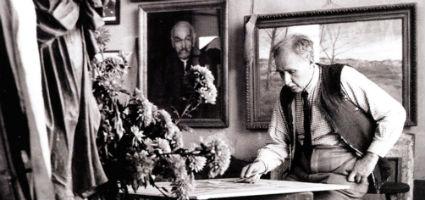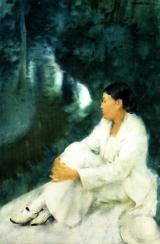2025. July 19. Saturday
Permanent Exhibition of the Painter József Horváth - Sopron
 |
Address: 9400, Sopron Hátsókapu utca 2.
Phone number: (99) 312-326
E-mail: bertalan.horvath@archikon.hu
Opening hours: Thu-Sun 10-13, Sat 15-18
On prior notice (99/313-540) |
"His art is highly regarded; his life is a paragon of virtue. If I wanted to characterise his art, I would recall those of his works in which his creative imagination believed itself beautiful and invulnerable. If I wanted to catch sight of his moral conduct, I would have to invoke his words and deeds."
In this introduction, the student - Ferenc (Sebesta) Sebestény (1907-1972), a painter born in Sopron who worked in Budapest, was one of József Horváth's most distinguished students - recalls his late teacher and friend, reverently trying to evoke his spirit.
Anyone who saw him would never forget his gigantic stature, which seemed to be the symbolic embodiment of his principled intransigence. Anyone who spoke with him, though, felt the warm humanity that permeated this moral hardness. I want to bear witness to the fact that there was no end to the affection he lavished on his students. His thoughtfulness and attention, being that of someone who is truly interested, never waned over the decades; not even for those who in time forgot his affection and ceased to return his love.
His entire life was imbued with a passion for teaching coupled with deep human interest and a desire to pass on knowledge. Perhaps the example of the artistic ethics of the Nagybánya painters and the intellectual legacy of his master, István Réti, also contributed to this.
His lifestyle was simpler than austere; it was ascetic. This was the price for being able to realise that for which he wagered his life - his artistic designs. This kind of lifestyle required considerable resolve, but József Horváth was a resolute man. His public role shows this. He did not seek this role, but when It came to him, he proved courageous and determined. The apocalyptic times of the recent past never shook the firmness of his principles and his humane cast of mind. He was courageous in action even when, in danger, he had to give help. Because his character was brave, true and unblemished. Only a great person can become a great artist. And this begins with moral courage.
For him, as for the Greeks, techné also meant art. Horváth knew that meticulousness was an important element of artistic work. Time spares nothing that is created without it. This kind of strength of conviction was necessary in order to limit himself to an area that most painters only regard as the preparatory stage of painting, so that later his talent in this field would be able to make a special type of art blossom. How would he have expressed his artistic creed? There is nothing in writing concerning this, nor did he ever mention anything in our conversations. He was not interested in putting into words what his art expressed so concisely. But I do not believe that he would have been adverse to this definition: Art is the free, beautiful interpretation of nature. His strength was that he had more artistic self-awareness than others. He recognised that in a small circle, he must be adamantly and steadfastly faithful, in principle and in deed, to what he has identified in himself as his own and of value. And this is no small virtue.
Isolated, ill and plagued by financial problems, he had almost the heroism of Socrates, who took harp lessons in his death cell. Horváth was at the height of his creative power when he died unexpectedly on 22 April 1961.
In this introduction, the student - Ferenc (Sebesta) Sebestény (1907-1972), a painter born in Sopron who worked in Budapest, was one of József Horváth's most distinguished students - recalls his late teacher and friend, reverently trying to evoke his spirit.
Anyone who saw him would never forget his gigantic stature, which seemed to be the symbolic embodiment of his principled intransigence. Anyone who spoke with him, though, felt the warm humanity that permeated this moral hardness. I want to bear witness to the fact that there was no end to the affection he lavished on his students. His thoughtfulness and attention, being that of someone who is truly interested, never waned over the decades; not even for those who in time forgot his affection and ceased to return his love.
His entire life was imbued with a passion for teaching coupled with deep human interest and a desire to pass on knowledge. Perhaps the example of the artistic ethics of the Nagybánya painters and the intellectual legacy of his master, István Réti, also contributed to this.
His lifestyle was simpler than austere; it was ascetic. This was the price for being able to realise that for which he wagered his life - his artistic designs. This kind of lifestyle required considerable resolve, but József Horváth was a resolute man. His public role shows this. He did not seek this role, but when It came to him, he proved courageous and determined. The apocalyptic times of the recent past never shook the firmness of his principles and his humane cast of mind. He was courageous in action even when, in danger, he had to give help. Because his character was brave, true and unblemished. Only a great person can become a great artist. And this begins with moral courage.
For him, as for the Greeks, techné also meant art. Horváth knew that meticulousness was an important element of artistic work. Time spares nothing that is created without it. This kind of strength of conviction was necessary in order to limit himself to an area that most painters only regard as the preparatory stage of painting, so that later his talent in this field would be able to make a special type of art blossom. How would he have expressed his artistic creed? There is nothing in writing concerning this, nor did he ever mention anything in our conversations. He was not interested in putting into words what his art expressed so concisely. But I do not believe that he would have been adverse to this definition: Art is the free, beautiful interpretation of nature. His strength was that he had more artistic self-awareness than others. He recognised that in a small circle, he must be adamantly and steadfastly faithful, in principle and in deed, to what he has identified in himself as his own and of value. And this is no small virtue.
Isolated, ill and plagued by financial problems, he had almost the heroism of Socrates, who took harp lessons in his death cell. Horváth was at the height of his creative power when he died unexpectedly on 22 April 1961.
